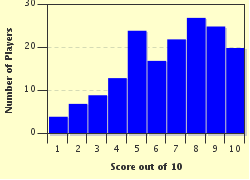Quiz Answer Key and Fun Facts
1. Long before Christianity reached Europe, ancient cultures were celebrating the winter solstice with a yuletide feast. Which of the following was NOT one of the warming drinks that was a welcome addition at these feasts?
2. People living in the Middle Ages often ate warming stews served on a bread plate which later evolved into a bread bowl. What alternative name was given to this food?
3. Peasants in Medieval England could not afford prime cuts of meat and instead were left with the edible entrails of any animal. Made into a pie, what was this known as?
4. Certain colleges and universities still carry out the tradition of singing which 15th century song at the start of their Christmas dinner?
5. King Henry VIII banned festive celebrations including eating mince pies and Christmas pudding in an effort to curb the nation's gluttony.
6. An elaborately decorated dessert during the Elizabethan era was made in a special mold and used three basic ingredients; sugar, almond and rosewater. What was it called?
7. On 25th December 1662, Samuel Pepys wrote in his diary, "having a mess of brave plum-porridge and a roasted pullet for dinner, and I sent for a mince-pie abroad, my wife not being well to make any herself yet." What was plum-porridge?
8. In the great houses of Georgian England, a highly decorated dessert was served which was the forerunner to today's Christmas cake. Inside was a pea, a bean, or a coin. Which cake am I describing?
9. Which popular Victorian parlour game was played on Christmas Eve and involved plucking currants from a bowl of burning brandy?
10. Which substitute roast turkey dinner, made from mutton, saw its arrival on the Christmas dinner table during World War II?
Source: Author
Plodd
This quiz was reviewed by FunTrivia editor
WesleyCrusher before going online.
Any errors found in FunTrivia content are routinely corrected through our feedback system.


